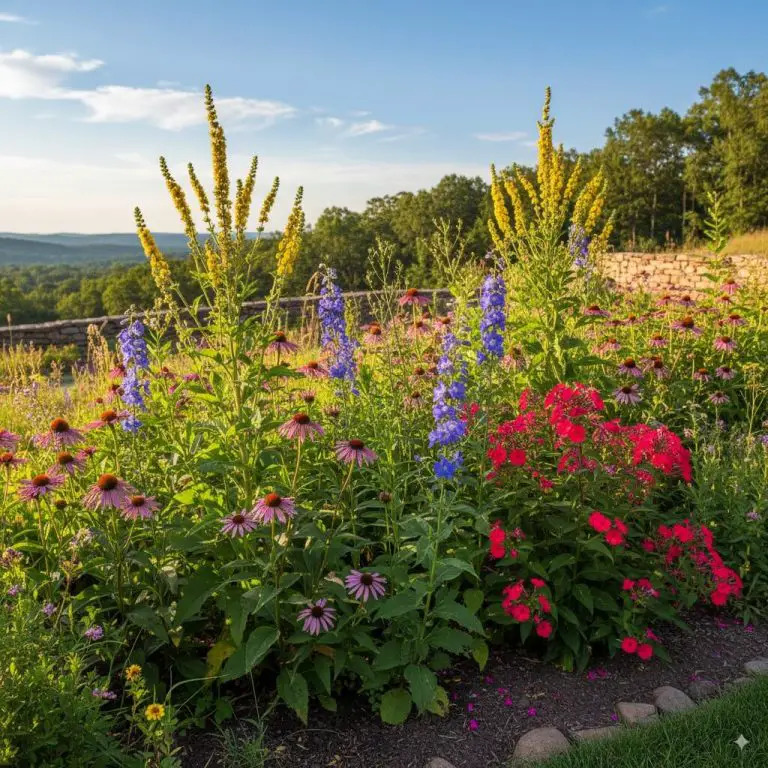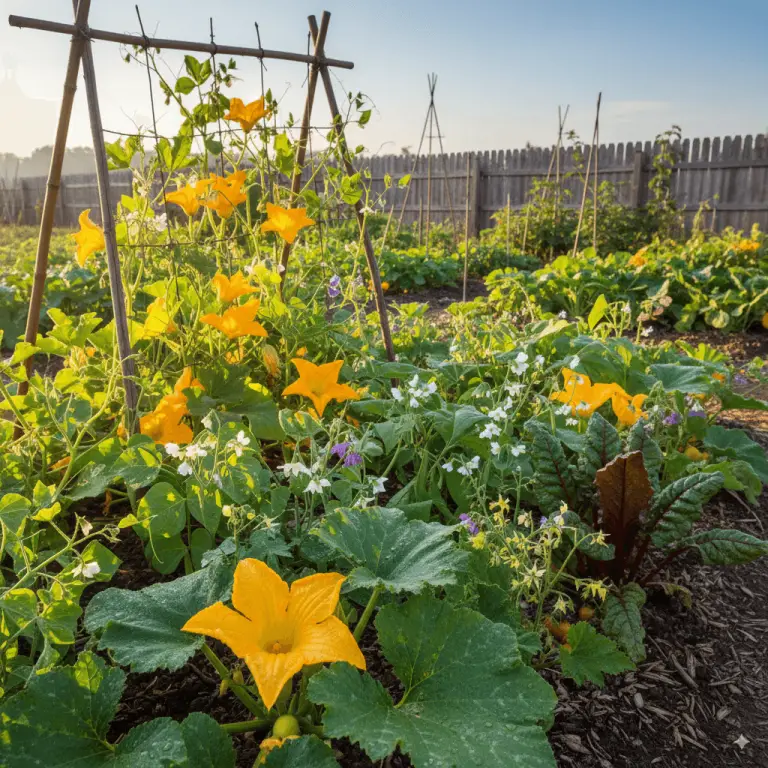Outdoor Tall Flowering Plants – Your Guide To Creating Stunning
Ever look at your garden and feel like it’s a little… flat? You’ve poured your heart into creating beautiful beds bursting with color, but somehow, it’s missing that “wow” factor. The secret to transforming a good garden into a breathtaking one often lies in reaching for the sky.
I promise, adding vertical dimension is easier than you think. This complete outdoor tall flowering plants guide is your friendly roadmap to creating a garden with stunning height, dynamic structure, and season-long interest. Forget feeling intimidated by towering stems!
We’re going to walk through everything together, from my absolute favorite beginner-friendly giants to the simple secrets of keeping them standing proud. You’ll learn how to choose, plant, and care for these beauties, turning your garden into a lush, multi-layered paradise. Let’s start growing upwards!
What's On the Page
- 1 Why Every Garden Needs a Touch of Height: The Benefits of Outdoor Tall Flowering Plants
- 2 Our Top Picks: The Best Outdoor Tall Flowering Plants for Every Garden
- 3 The Ultimate Outdoor Tall Flowering Plants Care Guide
- 4 Mastering the Art of Support: Staking and Best Practices
- 5 Troubleshooting Common Problems with Outdoor Tall Flowering Plants
- 6 Growing with a Conscience: Sustainable and Eco-Friendly Practices
- 7 Frequently Asked Questions About Outdoor Tall Flowering Plants
- 8 Your Garden’s New Heights Await
Why Every Garden Needs a Touch of Height: The Benefits of Outdoor Tall Flowering Plants
Think of your garden bed like a painting. Groundcovers and medium-sized plants create the beautiful foreground and middle, but tall flowers are the dramatic background that provides depth and context. They do so much more than just look pretty!
Here are some of the incredible benefits of outdoor tall flowering plants:

🌿 The Companion Planting & Gardening Book (eBook)
Bigger harvests, fewer pests — natural pairings & simple layouts. $2.40
Get – $2.40
🪴 The Pest-Free Indoor Garden (eBook)
DIY sprays & soil tips for bug-free houseplants. $1.99
Get – $1.99- Creates Visual Drama: Tall plants draw the eye upward, making your garden feel larger and more immersive. They act as “exclamation points,” breaking up horizontal lines and adding exciting rhythm.
- Builds a Living Privacy Screen: Strategically placed hollyhocks, sunflowers, or ornamental grasses can create a beautiful, natural screen for a patio or shield an unsightly view.
- Defines Garden “Rooms”: Use a row of tall delphiniums or foxgloves as a soft, living wall to separate different areas of your garden, creating intimate nooks and distinct spaces.
- Supports Pollinators: Many tall flowers like lupines and bee balm are magnets for bees, butterflies, and hummingbirds, turning your garden into a thriving ecosystem.
- Adds Movement and Sound: The gentle sway of tall stems and the rustle of leaves in the breeze bring a dynamic, sensory element to your outdoor space.
Our Top Picks: The Best Outdoor Tall Flowering Plants for Every Garden
Ready for the fun part? Choosing your plants! I’ve gathered a list of my tried-and-true favorites, perfect for both sun-drenched spots and shadier corners. Don’t worry—many of these are perfect for beginners!
Sun-Loving Superstars
These plants thrive in six or more hours of direct sunlight and will reward you with spectacular blooms.
- Delphinium (Delphinium elatum): The undisputed kings of the cottage garden. Their majestic spires of blue, purple, pink, or white flowers are simply breathtaking. They do require rich soil and consistent moisture to perform their best.
- Hollyhock (Alcea rosea): For a touch of old-fashioned charm, nothing beats a hollyhock. These biennials or short-lived perennials produce towering stalks lined with large, cup-shaped flowers. They are prone to rust, so ensure good air circulation.
- Sunflower (Helianthus annuus): The cheeriest giant in the garden! Sunflowers are incredibly easy to grow from seed and come in a huge range of sizes and colors, from classic yellow to deep burgundy. A fantastic project for gardening with kids.
- Foxglove (Digitalis purpurea): These elegant, bell-covered spires add a magical, woodland feel. Most are biennial, meaning they grow foliage the first year and flower the second. Important note: All parts of the foxglove plant are toxic if ingested, so plant with care around pets and small children.
- Lupine (Lupinus): With their densely packed, vibrant flower spikes, lupines are a showstopper. As a bonus, they are legumes, which means they fix nitrogen in the soil, benefiting the plants around them.
Shade-Tolerant Beauties
Have a spot that doesn’t get full sun? No problem! These plants will shine in partial or dappled shade.
- Astilbe (Astilbe chinensis): Known for their feathery, plume-like flowers in shades of pink, red, and white, astilbes bring soft texture and color to shady areas. They absolutely need consistently moist soil to thrive.
- Bugbane (Actaea racemosa): Don’t let the name fool you! This plant produces dramatic, fragrant, bottlebrush-like spires that can reach up to 6 feet tall. They are a fantastic late-summer bloomer when other plants are starting to fade.
- Goat’s Beard (Aruncus dioicus): A large, shrub-like perennial that creates a massive display of creamy-white, feathery plumes. It’s a wonderful, low-maintenance alternative to astilbe for larger spaces.
- Ligularia ‘The Rocket’ (Ligularia stenocephala): Valued for both its large, serrated leaves and its tall, bright yellow flower spikes. It loves boggy, wet conditions, making it perfect for damp corners of the garden.
- Japanese Anemone (Anemone hupehensis): A graceful and elegant bloomer for late summer and fall. Its charming, poppy-like flowers dance on tall, wiry stems, bringing life to the garden when you need it most.
The Ultimate Outdoor Tall Flowering Plants Care Guide
Growing tall plants successfully comes down to a few key principles. This section covers exactly how to outdoor tall flowering plants with confidence. Think of it as your go-to cheat sheet for vertical success.
Getting the Foundation Right: Soil and Planting
Tall plants have big root systems and need a solid foundation. Before planting, amend your soil with plenty of organic compost. This improves drainage in heavy clay soil and helps retain moisture in sandy soil—a win-win!
When planting, dig a hole that’s twice as wide as the plant’s container but just as deep. Give them space! Check the plant tag for spacing recommendations, but a good rule of thumb is to allow at least 18-24 inches between plants for proper air circulation, which helps prevent disease.
Watering Wisely: Quenching Thirsty Giants
Tall plants have a lot of foliage and can lose water quickly, especially on windy days. The key is to water deeply and infrequently rather than giving them a shallow sprinkle every day. This encourages roots to grow deep into the soil, making the plant more stable and drought-tolerant.
A 2-3 inch layer of organic mulch (like shredded bark or compost) around the base of the plant is your best friend. It helps retain soil moisture, keeps roots cool, and suppresses weeds.
Feeding for Success: Fueling the Flowers
While good soil is the best start, these hard-working plants appreciate a little extra fuel. In the spring, as new growth appears, feed them with a balanced, slow-release granular fertilizer. Avoid high-nitrogen fertilizers, which can lead to lots of leafy growth but fewer flowers and weak, floppy stems.
Mastering the Art of Support: Staking and Best Practices
Let’s be honest: the biggest fear for any gardener growing tall plants is the “great flop.” A single storm can lay your beautiful delphiniums flat. The secret is proactive support. Here are some outdoor tall flowering plants best practices for staking.
When and Why to Stake
The best time to add support is early in the season, when the plant is about one-third of its final height. This allows the plant to grow up and through the support, hiding it naturally within its foliage. Waiting until it’s already leaning is too late—you risk damaging the stems trying to wrestle it back into place.
Types of Supports for Your Plants
- Single Stakes: Best for plants with a single, strong central stalk, like sunflowers or hollyhocks. Use soft ties (like strips of old t-shirts or garden twine) to loosely secure the stem to the stake in a figure-eight loop.
- Grow-Through Grids: These metal grids on legs are perfect for multi-stemmed, clumping plants like peonies or goat’s beard. Place the grid over the plant when it’s small, and it will grow right through it, getting support without being constricted.
- Cages: Similar to tomato cages, these are ideal for bushy plants like delphiniums or tall dahlias. The cage provides a 360-degree support system.
- The “Chelsea Chop”: A pro tip! For late-summer bloomers like asters or sedum, you can cut them back by about one-third in late spring (around the time of the Chelsea Flower Show in the UK). This encourages bushier, sturdier growth and slightly later blooms, reducing the need for staking.
Troubleshooting Common Problems with Outdoor Tall Flowering Plants
Even with the best care, you might run into a few hiccups. Don’t get discouraged! Here’s how to handle the most common problems with outdoor tall flowering plants.
The Dreaded Flop: Why Are My Plants Falling Over?
If your plants are flopping despite your best efforts, it’s usually due to one of three things:
- Too Much Nitrogen: As mentioned, excess nitrogen fertilizer creates weak, lanky stems.
- Not Enough Sun: Plants will stretch and become “leggy” as they reach for sunlight, making them unstable.
- Lack of Support: They simply need a helping hand! Even the sturdiest plants can be toppled by wind and heavy rain.
Pesky Pests and Diseases
Good air circulation is your number one defense. Powdery mildew is a common foe, especially for hollyhocks and bee balm. To prevent it, give plants plenty of space and water at the base, not on the leaves. If you see pests like aphids, a strong spray of water from the hose or an application of insecticidal soap can often do the trick.
Growing with a Conscience: Sustainable and Eco-Friendly Practices
Creating a beautiful garden can and should go hand-in-hand with caring for our planet. Embracing sustainable outdoor tall flowering plants is all about making smart, gentle choices.
Choosing Native Varieties
Whenever possible, opt for tall flowering plants that are native to your region. Plants like Joe Pye Weed (Eutrochium purpureum) or Culver’s Root (Veronicastrum virginicum) are adapted to your local climate and provide essential food and habitat for local pollinators and wildlife.
Water Conservation and Natural Pest Control
Adopting eco-friendly outdoor tall flowering plants practices is simple. Use drip irrigation or soaker hoses to deliver water directly to the roots, minimizing evaporation. Encourage beneficial insects like ladybugs and lacewings by planting a diversity of flowers; they are your best allies in natural pest control!
Frequently Asked Questions About Outdoor Tall Flowering Plants
What are the easiest tall flowering plants for beginners?
For a fantastic and nearly foolproof start, I highly recommend Sunflowers (Helianthus), Hollyhocks (Alcea), and Lupines (Lupinus). They are generally robust, easy to grow from seed or starts, and provide a huge visual reward for your effort.
How do I stop my tall plants from being damaged by wind?
Proper staking is your best defense. Additionally, try planting your tallest flowers near a wall, fence, or hedge that can act as a natural windbreak. Planting in groups or “drifts” also allows the plants to support each other.
Can I grow tall flowering plants in containers?
Absolutely! The key is to choose a very large container—think half-whiskey barrel size—to provide enough soil volume and stability. Look for more compact tall varieties, such as dwarf sunflowers or certain types of Canna Lilies and Dahlias, which are well-suited for pot culture.
Your Garden’s New Heights Await
You now have all the tools and outdoor tall flowering plants tips you need to add that missing vertical layer to your garden. It’s all about choosing the right plant for the right place, giving it a little support, and not being afraid to experiment.
Remember that gardening is a journey, not a destination. Start with just one or two tall varieties this season. Watch how they transform the space, how they dance in the wind, and how they draw in a whole new world of buzzing visitors.
Go ahead, reach for the sky. Your garden will thank you for it!
- Conifers For Small Gardens – Your Ultimate Guide To Year-Round Beauty - December 10, 2025
- Shade Conifer Trees – Cultivating Evergreen Splendor In Tricky Garden - December 10, 2025
- Conifer Flowers – Unveiling Their Hidden Beauty And How To Cultivate A - December 10, 2025



